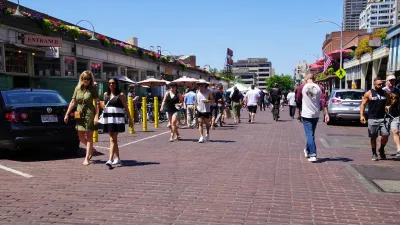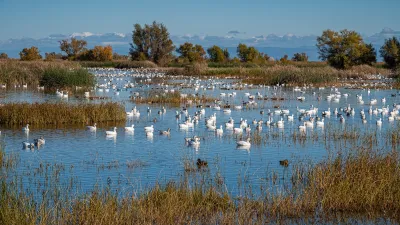Using two paradigms addressing synergies of nature and the city, Chuck Wolfe contrasts gradually merging animal and human habitats in the United States with calculated greening of city spaces overseas.
Writing in Atlantic Cities, Wolfe compares an encounter with a "feral, walkable urbanist" coyote on a Seattle sidewalk with the tactful greening of a former motorway ramp within Madrid's Rio Project.
"Successful integration of nature and the city is a hallmark of sustainability", he notes, "Sometimes it occurs without effort or provocation, while other times it results from projects or plans. In both instances, the natural and artificial merge, morph and redefine urban reality going forward."
He uses the perspective of two landscape architects to explain different ways that city and nature merge. Under one approach, such as changing coyote habitats, surrounding nature merges with urban culture and physical form, two things that need not be as distinct as we might expect. The second, equally compelling approach recognizes that there is nothing natural in the city, and any insertion of nature into the urban fabric that resonates with the public and creates a sustainable result, is defensible, proper and legitimate.
Wolfe concludes with a nuanced view that combines the two perspectives:
[W]hile there is arguably nothing natural in the constructed city, the proposition has its exceptions, or compromises... From multiple perspectives, the role of nature and the city will continue to realign. In fact, before too long, our cities' versions of Madrid’s green, re-purposed motorway ramp may have some non-human users along the way.
FULL STORY: What the Urban Coyote Can Teach Us About Nature in Cities

Study: Maui’s Plan to Convert Vacation Rentals to Long-Term Housing Could Cause Nearly $1 Billion Economic Loss
The plan would reduce visitor accommodation by 25,% resulting in 1,900 jobs lost.

North Texas Transit Leaders Tout Benefits of TOD for Growing Region
At a summit focused on transit-oriented development, policymakers discussed how North Texas’ expanded light rail system can serve as a tool for economic growth.

Why Should We Subsidize Public Transportation?
Many public transit agencies face financial stress due to rising costs, declining fare revenue, and declining subsidies. Transit advocates must provide a strong business case for increasing public transit funding.

How to Make US Trains Faster
Changes to boarding platforms and a switch to electric trains could improve U.S. passenger rail service without the added cost of high-speed rail.

Columbia’s Revitalized ‘Loop’ Is a Hub for Local Entrepreneurs
A focus on small businesses is helping a commercial corridor in Columbia, Missouri thrive.

Invasive Insect Threatens Minnesota’s Ash Forests
The Emerald Ash Borer is a rapidly spreading invasive pest threatening Minnesota’s ash trees, and homeowners are encouraged to plant diverse replacement species, avoid moving ash firewood, and monitor for signs of infestation.
Urban Design for Planners 1: Software Tools
This six-course series explores essential urban design concepts using open source software and equips planners with the tools they need to participate fully in the urban design process.
Planning for Universal Design
Learn the tools for implementing Universal Design in planning regulations.
City of Santa Clarita
Ascent Environmental
Institute for Housing and Urban Development Studies (IHS)
City of Grandview
Harvard GSD Executive Education
Toledo-Lucas County Plan Commissions
Salt Lake City
NYU Wagner Graduate School of Public Service





























